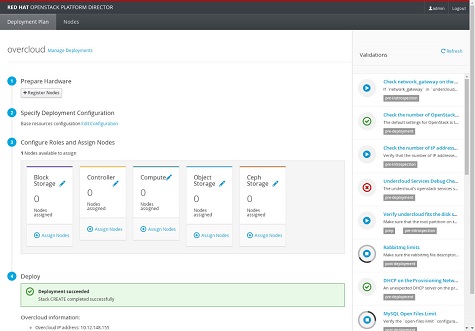Red Hat OpenStack Platform 10 Simplifies OpenStack
Red Hat announced the official release of its cloud Infrastructure-as-a-Service (IaaS) solution, OpenStack Platform 10 (RHOP 10), providing users with the option for up to five years of support. The new upgrade is based on the open-source OpenStack Newton release, launched October 6. OpenStack Platform 10 is designed to address the challenge of deployment complexity.
 CMS-Connected reached out Radhesh Balakrishnan, General Manager for OpenStack at Red Hat, to inquire what the new platform means for the future of the open source community, and he stated: “With this release, we've significantly improved usability and scalability in response to feedback from hundreds of customers with production deployments of Red Hat OpenStack Platform. Coupled with our broad partner ecosystem, this version of our offering sets the stage for ubiquitous adoption of OpenStack as the open infrastructure fabric across enterprises and Communications Service Providers.” We also asked him what the next capabilities are, users should expect to see from Red Hat in the near future, here's what he had to say: “In the future releases, we will be continuing to focus on innovations to improve the Reliability, Availability and Serviceability of Red Hat OpenStack Platform, in line with our mission to deliver production-ready open source solutions to customers embracing hybrid clouds.” In the press release, he also emphasized: “Red Hat OpenStack Platform 10 drives the enterprise-readiness of OpenStack by delivering a stable, reliable and open foundation for cloud deployments, delivering new innovations like composable services and roles while retaining our commitment to enterprise stability, highlighted by our new Long Life support model.”
CMS-Connected reached out Radhesh Balakrishnan, General Manager for OpenStack at Red Hat, to inquire what the new platform means for the future of the open source community, and he stated: “With this release, we've significantly improved usability and scalability in response to feedback from hundreds of customers with production deployments of Red Hat OpenStack Platform. Coupled with our broad partner ecosystem, this version of our offering sets the stage for ubiquitous adoption of OpenStack as the open infrastructure fabric across enterprises and Communications Service Providers.” We also asked him what the next capabilities are, users should expect to see from Red Hat in the near future, here's what he had to say: “In the future releases, we will be continuing to focus on innovations to improve the Reliability, Availability and Serviceability of Red Hat OpenStack Platform, in line with our mission to deliver production-ready open source solutions to customers embracing hybrid clouds.” In the press release, he also emphasized: “Red Hat OpenStack Platform 10 drives the enterprise-readiness of OpenStack by delivering a stable, reliable and open foundation for cloud deployments, delivering new innovations like composable services and roles while retaining our commitment to enterprise stability, highlighted by our new Long Life support model.”
The RHOP 10 comes with enhanced scale and automation tools, as well as a new container cluster orchestration manager, a container-networking project and a bare-metal server provisioning service. Here are some enhancements:
-
The platform reduces the complexities of installation and management through a graphical user interface (GUI), meaning that organizations can easily customize exactly what OpenStack components they want to deploy. Additionally, GUI provides several newly integrated functions, such as automatic upgrades and updates (including Ceph), advanced networking configuration, high availability, and the option to deploy file sharing via the Manila service, using the integrated drivers available from NetApp and Red Hat Ceph Storage.
-
Now that the platform allows organizations to manage the components more independently of each other, OpenStack's compute, storage and networking services can be customized through the introduction of customizable services and administration roles using Red Hat OpenStack Platform director.
-
The new data plane developer kit (DPDK) component of Open vSwitch and single-root input/output virtualization (SR-IOV) enables users to improve performance for the network-intensive workload. The company claims that it delivers network performance comparable to bare metal. Additionally, network routing is now more flexible and faster, allowing customers to choose between centralized routing or distributed routing (DVR).
-
Although Red Hat already supports certified hardware plug-ins for several OpenStack components, with the new “ready state” hardware certification program, Red Hat will expand the ecosystem of hardware options for automated bare-metal configuration. According to the company, Dell EMC is the first Red Hat partner to be certified for Red Hat OpenStack Platform 10 ready-state, with several more coming soon.
Speaking of partnership, Red Hat also introduced "distributed continuous integration" with its OpenStack partners. Those partners include Dell EMC, NEC Corp., and Rackspace. The primary purpose of this collaboration is to shorten the development and test time of OpenStack Platform from, initially, five months to two. The ultimate goal is to move to “within weeks” in the future. How will that happen? The partners under this program will test their hardware as new versions of OpenStack Platform evolve so the company will no longer wait until the end of the production process to test. Red hat believes, as a result, they will provide customers with greater stability and higher quality cloud solutions that have been tested many times over with their uniquely integrated cloud system than previously offered. In the long run, DCI could be extended to include customers.
Jim Ganthier, Senior Vice President, Validated Solutions and HPC, Dell EMC Converged Platforms and  Solution Division: “Dell EMC and Red Hat’s close engineering and collaboration efforts continue to help our joint customers to quickly deploy and manage OpenStack-powered clouds. We are pleased to have worked closely with Red Hat to both refine and build the new distributed continuous integration partner testing process which accelerates both code testing, validation and the ability to deliver robust software to customers. Red Hat’s new OpenStack Platform 10 lifecycle model for support will also offer more subscription flexibility for mission-critical operations and strengthens our joint ability to support customers throughout the entire lifecycle of their OpenStack deployments.”
Solution Division: “Dell EMC and Red Hat’s close engineering and collaboration efforts continue to help our joint customers to quickly deploy and manage OpenStack-powered clouds. We are pleased to have worked closely with Red Hat to both refine and build the new distributed continuous integration partner testing process which accelerates both code testing, validation and the ability to deliver robust software to customers. Red Hat’s new OpenStack Platform 10 lifecycle model for support will also offer more subscription flexibility for mission-critical operations and strengthens our joint ability to support customers throughout the entire lifecycle of their OpenStack deployments.”
Red Hat has been collaborating with Cisco and Dell-EMC to leverage its platform for enterprises while being co-engineered with Nokia, Alcatel-Lucent, Ericsson, and Cisco in order to deliver turnkey OpenStack platforms for carriers.
New Support Model
Another prominent highlight of the new release is that Red Hat is now providing its users with up to five years of support for its OpenStack Cloud Platform. The company introduces a dual support life cycle model that offers greater subscription flexibility for mission-critical operations. This new model gives customers the option of standardizing on a new “Long Life” version of Red Hat OpenStack Platform, offering a three-year product lifecycle and optional two additional years of extended life cycle (ELS) support available for purchase. It means that every third version of Red Hat OpenStack Platform will receive three years of support that is extensible to five. For Red Hat OpenStack Platform versions in between major releases, customers will receive one year of support. On a related note, Red Hat already offers 10 years of support for its Enterprise Linux customers. Customers can also choose to focus on consuming new feature functionality by using rolling upgrades to follow the latest releases of Red Hat OpenStack Platform every six months to one year.
To help customers achieve long-term stability required by their specific workload requirements, Red Hat OpenStack Platform 10 introduces a dual support life cycle model that offers greater subscription flexibility for mission-critical operations. This new model gives customers the option of standardizing on a new “Long Life” version of Red Hat OpenStack Platform, offering a three-year product lifecycle and optional two additional years of extended life cycle (ELS) support available for purchase. Customers can also choose to focus on consuming new feature functionality by using rolling upgrades to follow the latest releases of Red Hat OpenStack Platform every six months to one year.
OpenStack sees upgrades on a fast pace, and Red Hat has typically followed each upstream OpenStack release by several months with its own OpenStack Platform release. With the Red Hat OpenStack Platform Director, users can install and manage all the tasks of a complete OpenStack environment. The toolset is leveraged with the release of OpenStack Platform 10. There are two options to upgrade your version: the in-place migration approach or a standard migration. The in-place migration approach is powered by the OpenStack Director tool and requires an upgrade every six months. For those who are not able to do a rolling upgrade, a standard migration is recommended which requires you to deploy a new cloud and move the data and workloads from the old version to the new one. In an interview with eWeek, Balakrishnan stated: "We are planning on delivering tooling to ease the challenges posed by this option in future releases."

With the latest release, Red Hat aimed at easing the transition to production and OpenStack installation complexity. This will generate a lot of buzz in the OpenStack cloud computing community, as OpenStack is often considered as a hard-to-deploy cloud platform, and now it is easier to roll out. To me, the timing is great in favor of the company as it can specifically pique the interest of Hewlett-Packard Enterprise customers due to last month's acquisition of Hewlett-Packard Enterprise's own branded OpenStack and Cloud Foundry platforms, by open source specialist SUSE. The introduction of Distributed Continuous Integration is another new deployment that will pay off in no time.

Venus Tamturk
Venus is the Media Reporter for CMS-Connected, with one of her tasks to write thorough articles by creating the most up-to-date and engaging content using B2B digital marketing. She enjoys increasing brand equity and conversion through the strategic use of social media channels and integrated media marketing plans.